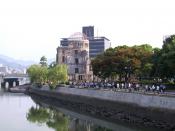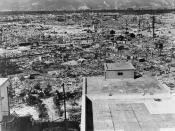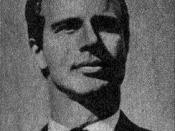Hiroshima was a terrible event that occurred on August 6th, 1945. In this novel, John Hersey interviews six survivors who were first-hand witnesses of the event. These six people tell their stories from hours before the bomb dropped, to almost four decades after it occurred, to get a glimpse of reality on the horrible crime that affected thousands of people forever. The six people are as follows:
The Reverend Mr. Kiyoshi Tanimoto, who was educated in America, was helping a friend move some of his daughter's belongings to a house outside of the city center. They are about two miles away from the center of the blast, but the bomb still levels the house as Mr. Tanimoto takes cover in a rock garden.
Mrs. Hatsuyo Nakamura, a tailor's widow, was tired from repeatedly taking her three young children to a safe area in response to every warning. When the air-raid siren sounded early in that very morning, Mrs.
Nakamura decides to stay home and let her children sleep unless she hears a more urgent warning. When the bomb stroke about three-quarters of a mile from her house, she was watching her neighbor tear down his own home in order to help clear fire lanes.
Dr. Masakazu Fujii ran a private hospital right by a river. Because of the difficulty of evacuating his patients in the event of an air raid, he has turned away all but two patients. When he returned from accompanying a friend on a train station (he had awaken earlier than usual for this), sat on a porch to read the paper. When the bombs stroke, it destroyed the building he was in and sent Mr. Fuiji into the river.
Father Wilhelm Kleinsorge was a German Jesuit priest stationed at a mission house in Hiroshima. Recently weakened by diarrhea from the wretched wartime rations, he was resting and reading a magazine in his room when the bomb stroke. The mission house, which has been double-braced for earthquakes, does not get destroyed, and Kleinsorge and his fellow priests survive.
Dr. Terufumi Sasaki was a twenty-five-year-old surgeon at the Red Cross Hospital. Because of two strokes of luck, Dr. Sasaki managed to survive the blast with no scratches, bruises, etc. First, that morning he had taken an earlier train than usual because he couldn't sleep(based on the location and timing of the blast, he would have been killed on his normal train). Second, when the bomb hits, he is safe-standing one step away from an open window. He is the only doctor in the hospital who is uninjured, and he immediately starts helping people hurt from the explosion.
Miss Toshiko Sasaki was a twenty-year-old clerk at the East Asia Tin Works, working to support her brother and parents. She was sitting in her office when the bomb stroke. The blast knocked over a bookcase on top of her that crushes her leg, and eventually, she lost consciousness.
Mr. Tanimato at first believed that the destruction was only around him, but once he got a glimpse of the area he realized that the extent of the destruction was much bigger. He then ran back into the city to find his wife and baby daughter and miraculously does so as he runs through the streets. He then felt sort of ashamed realizing that he was not hurt at all, as others were suffering greatly.
Mrs. Nakamura digs out her three children and finds out that her children were all unharmed. They all head to Asano Park, which was designed as an evacuation area on the outskirts of the city.
Father Kleinsorge is slightly injured, but one of the other priests, Father Schiffer, is bleeding from the head. Some of the other priests attempt to get Father Schiffer to a hospital and dig out other victims under the destruction, while Father Kliensorge gets together some of his belongings. Mr. Fukai refuses to leave the mission house, and his then carried out by Father Kleinsorge forcefully. However, Kleinsorge eventually can not go on any longer because of his diarrhea and Father Fukai then runs off back to the mission house, never to be seen again.
Both Dr. Sasaki and Dr. Fuiji survive the blast; but Dr. Fuiji is hurt and his clinic is destroyed in ruins. Dr. Sasaki is one of the only doctors that survived the blast and soon after 10,000 injured people crowd his clinic. Dr. Sasaki, completely confused and wearing someone else's glasses (he wears this pair for a month), Sasaki then starts to wrap up the victims and give them as much care as he can.
Miss Sasaki, at the tin works factory, has been severely injured--her leg is so badly broken below the knee that she believes it has been cut off. For a long time, she is pinned below the bookcase, barely conscious, until she is finally pulled from the wreckage and put under a makeshift shelter in the company of two severely injured people.
Asano Park survives the explosion undamaged, and serves for a time as a "safe haven" for many of the citizens of Hiroshima, who lay suffering in silence. Many, including Mrs. Nakamura and her children, drink river water to stop their thirst and they spend the rest of the day vomiting by the riverbanks as a result. The spreading fire soon threatens the park, and the overcrowding of the riverbanks forces a number of people into the river to drown. Mr. Tanimoto leads a group of volunteers, including Father Kleinsorge, to put out the fire using clothing and buckets of water. He also finds a boat and begins transporting people who cannot move themselves to other places to rest. It starts to rain and the wind increases, eventually to the point to knocking down trees.
Mr. Tanimoto and Father Kleinsorge head back to the town to get supplies for the group. Back at the park they meet Mrs. Kakmai, who is holding a dead baby in her arms, desperate to find her husband (solidier).
The night of the explosion, a naval ship travels up and down the rivers of Hiroshima telling people to be patient and that aid was coming. This was the first event of communication since after the bombing occurred.
Other priests arrive to aid Father Schiffer and Father Lasalle with stretchers. Father Kleinsorge, on the other hand, is almost too ill to move. Despite his agony, he still finds enough strength to bring water to the injured from a faucet which he had found. Comforting everyone by telling them aid was coming, Father Kliensorge sadly knew that the aid was never coming. The government via broadcast tells the few watching that they believe that the bomb used was a new type of bomb invented.
Mr. Tanimoto finds more and more injured people on the riverbanks and on the river itself. He then helps to girls shivering and brings them to the park (one dies as soon as they reach the park). He then tries to save twenty men and women, but takes a rest as doing so and later finds out that he didn't bring them up high enough and that many of them drowned under the tide. He then travels to the medical station on East Parade Ground and confronts a doctor for not helping those on Asano Park. The overburdened doctor says that he is trying to save as many lives as he can and that the less-injured have more of a chance to stay alive. Therefore, the badly injured would have to wait in line behind the less injured.
No one seems more horrified than Dr. Sasaki, who does his best to stop the rising number of corpses at the Red Cross Hospital. He works for nineteen straight hours as the number of bodies around him piles up (there is nobody to take the corpses away) then manages an hour of sleep before he is up again, helping pateints. He works straight through the next three days, and does not return home until August 8 to assure his mother that he is alive. Dr. Fujii, meanwhile, is still too hurt to help anyone but himself and lies in pain on the floor of his parents' roofless house. Eventually he makes it to a friend's house outside of the city, where he is visited by Father Cieslik.
Miss Sasaki lies abandoned and helpless for two days and two nights under her "homemade cabin" in the courtyard of the tin works factory. Two days after the attack, some friends find her and tell her that her mother, father, and baby brother are all dead. Finally she is taken to a series of hospitals, where she hears doctors discuss whether to amputate her leg or not. It turns out to be badly fractured but not gangrenous, and eventually she arrives at a military hospital on the island of Ninoshima.
In the week after the blast the doctors are still completely unable to cope with the thousands who are wounded. On August 11th, Miss Sasaki is evacuated from the island military hospital and put on the deck of a ship. There, in the heat of the sun, the infection in her leg grows worse. At the Red Cross Hospital, the doctors are just beginning to get control of the number of dead bodies, cremating the corpses and stuffing the ashes into X-ray envelopes. The envelopes are labeled and stacked in a makeshift shrine in a hospital room.
On the morning of August 15th, Emperor Tenno reads the news over the radio: Japan has surrendered unconditionally, and the war is over.
Some weeks after the explosion, some of the main characters fall victim to radiation sickness. Father Kleinsorge is walking through the city to deposit money in Hiroshima when he suddenly becomes weak and barely makes it back to the mission. Mrs. Nakamura's hair begins to fall out, and she and her daughter become ill.
Miss Sasaki is transferred to the Red Cross Hospital in Hiroshima and placed under the care of Dr. Sasaki. Dr. Sasaki notices small hemorrhages all over her bare skin, a symptom many of his patients are beginning to show. He later discovers that this is the result of her low white-blood cell count, another symptom of radiation sickness.
In the next few months Mrs. Nakamura and Mr. Tanimoto eventually get better, but Father Kleinsorge continues to have a high fever and low blood cell count; and he is then sent to a hospital in Tokyo. The doctor there predicts he will die in two weeks, but Kleinsorge lives, as his blood count swings wildly up and down and his cuts constantly reopening. Once his fever is gone and his health relatively stable, he is interviewed by curious doctors, experts, and newspaper reporters.
In Hiroshima, as Japanese physicists make observations about the blast area, Dr. Sasaki and his colleagues develop new theories about radiation sickness by observing their patients. Miss Sasaki's infection lingers on eleven weeks after the bomb, and she remains in the hospital through November. She becomes extremely depressed. Father Kleinsorge, who has since returned to the city, comes to visit her in the hospital. For the next several months, Miss Sasaki seems to draw strength from the priest. By the end of April her infection is gone and she is able to walk on crutches.
One by one each of the characters, like Miss Sasaki, begins to resume some sort of a normal life. Dr. Fujii opens a new clinic and capitalizes on Japan's new visitors by treating American patients. Father Kleinsorge and another priest commission a three-story mission house exactly like the one they had lost; Father Kleinsorge eventually becomes so busy that he falls ill again and must return to the Tokyo hospital to rest. Mr. Tanimoto attempts to restore his own church in the city, but he does not have as much money as the Jesuits. Mrs. Nakamura, when her hair has grown back, scrapes together her money and rents a small shack near the site of her old house, while putting her children back into school in Hiroshima. Dr. Sasaki, after almost never leaving the hospital building in the four months after the blast, begins to focus on his own life and marries in March.



Hiroshima
Yours is an interesting essay on John Hersey's famous book. By focusing on the individual stories of several survivors, Hersey succeeds in bringing to life the tragic events surrounding the dropping of the atomic bomb on Hiroshima on August 6, 1945. It is reassuring to know that people can overcome even the most catastrophic events and regain some degree of normalcy in their lives. Let us all hope that atomic warfare is never resorted to again. Your report is informative and descriptive. Nice effort!
11 out of 11 people found this comment useful.